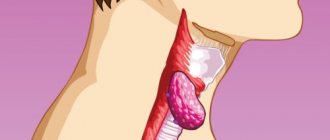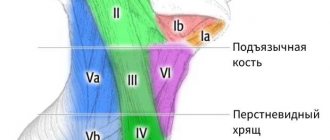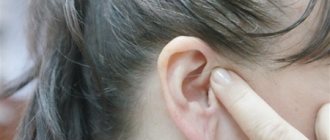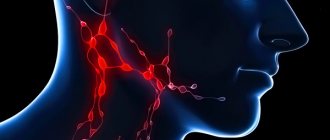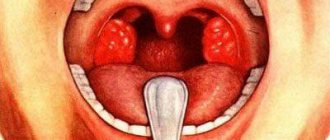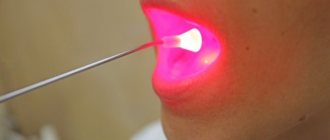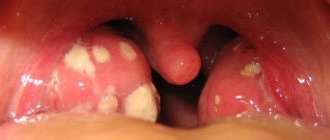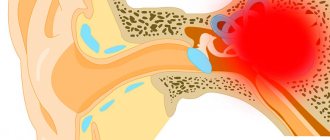Causes of lymphadenitis
Pathogenic microorganisms, entering the lymph nodes, linger there and activate protective and immune functions. Inflammation of the lymph nodes in the neck during angina is accompanied by the proliferation of plasma cells and the production of sensitized T-lymphocytes that regulate cellular immunity. In the nodes themselves, swelling and tissue infiltration, vasodilation, and accumulation of serous exudate occur. Hyperplasia of the lymphoid elements occurs, which is clinically accompanied by enlarged lymph nodes and pain.
The main reasons for enlarged lymph nodes during angina or chronic tonsillitis include:
- Bacterial infection. Most often it is beta - hemolytic streptococcus of group A, less often staphylococci, pneumococci.
- Viruses. Most often, sore throat is caused by adenoviruses, enteroviruses, and the herpes virus.
- Fungal infection (candidiasis).
- Chronic inflammatory processes in the sinuses (sinusitis).
- Oral disease (pharyngitis, stomatitis, laryngitis).
- Pathology of teeth and gums: caries, gingivitis, periodontal disease.
- The presence of foci of chronic infection in the body (chronic pancreatitis, pyelonephritis, cholecystitis).
- Weakening of the body's immune forces and allergic conditions.
- Chronic tonsillitis.
- HIV infection.
- Abscesses, boils, carbuncles on the skin.
Bacterial infection is one of the causes of enlarged lymph nodes with angina.
Also predisposing factors are local and general hypothermia, decreased reactivity of the body.
Inflammation of the lymph nodes with angina
When bacteria or viruses enter the oral cavity, they first settle on the tonsils, and if they cannot cope with the bacteria, the infection spreads further throughout the body and affects the lymph nodes
Sore throat and acute inflammation of the lymph nodes are pathological conditions that occur simultaneously. A sore throat is most often caused by streptococcus. The lymphatic system is trying to fight it, which explains the increase in the size of its formations. Along with this, the patient experiences other symptoms of malaise that negatively affect his overall well-being.
Inflammation of the lymph nodes, which occurs with a sore throat or other infectious disease, is indicated in ICD 10 under code R59.
Enlargement of the lymph nodes with progressive angina occurs due to the fact that they contain bacterial agents. In this way, the lymph nodes fight harmful microorganisms that lead to the development of infectious pathologies.
Causes
To understand why inflammation of individual lymph nodes in the neck occurs during sore throat, it is necessary to understand the mechanism of their work.
When the lymph nodes become enlarged due to sore throat, this is accompanied by a sore throat when swallowing. This symptom cannot be ignored, so it forces the patient to consult a doctor and begin therapy.
The fact that the lymph nodes increased during the development of angina is explained as follows. Various pathogenic microorganisms penetrate into the human oral cavity (in case of sore throat, most often streptococci). They can settle on the surface of the tonsils. If these lymphoid structures do not suppress their activity, then pathogenic agents are absorbed and destroyed by lymph nodes located nearby.
Most often with angina, the cervical lymph nodes are enlarged. They react to a streptococcal attack.
Symptoms
Sore throat is often accompanied by an inflammatory process of the lymph nodes that are located in the affected area (lymphadenitis). In order to promptly recognize the disease and consult a doctor with a complaint, you need to know the clinical manifestations of these pathological conditions:
- increasing pain in the throat when swallowing;
- increased body temperature;
- general malaise and weakness;
- an increase in the size of the lymph nodes, which can be determined during palpation.
The patient will also experience symptoms characteristic of a sore throat. We are talking about the covering of the tonsils with a white coating and difficulty swallowing.
Complications after a sore throat
If a patient has developed an abscess (due to a sore throat), this is an indication for immediate surgery: opening the abscess
If you do not begin to treat lymphadenitis (inflammation of the lymph nodes) during the development and after a sore throat, it will lead to serious complications. The lack of adequate therapy results in the formation of an abscess or adenophlegmon for the patient. Their development is characterized by a severe course and the appearance of symptoms of general intoxication:
- high body temperature;
- redness of the skin at the location of the lymph node;
- hyperemia that extends beyond the affected area;
- headache;
- muscle pain;
- pronounced weakness.
Clinical manifestations
The main symptoms of lymphadenitis with angina include:
- An increase in the size of the lymph nodes (submandibular, anterior cervical or posterior cervical).
- Lymph nodes are painful on palpation, the skin over them is unchanged and has a normal color.
- The nodes themselves are dense, homogeneous, and have an elastic consistency.
Lymph nodes are mobile and not fused with surrounding tissues.
With angina, inflammation of the lymph nodes is accompanied by the following clinical picture:
- An increase in temperature, most often to fibril levels (38 - 39 degrees) in the first days.
- Sore throat that gets worse when swallowing saliva or food.
- Loose, enlarged, hyperemic tonsils.
- Manifestations of general intoxication (chills, headaches, loss of appetite, fatigue, tiredness).
- Formation of plaque or pus in the lacunae of the tonsils.
Inflamed lymph nodes in acute angina increase sharply. The inflammatory process is facilitated by the accumulation of pathogenic microorganisms in the lymph nodes. Their breakdown products and the release of toxins contribute to rapid inflammation and an increase in the size of the lymph nodes.
There are several stages of development of lymphadenitis with angina. The initial serous stage develops at the very beginning of the disease. The lymph nodes enlarge slightly, the pain is not very pronounced. Enlarged nodes are round or oval in shape, their diameter does not exceed 10 mm. With a favorable course of the pathology and timely treatment, the enlarged lymph nodes decrease in size, become soft in consistency, and pain disappears.
Purulent lymphadenitis with angina rarely develops. This form can occur only in complicated forms of the disease, in the absence of adequate treatment, in weakened patients. The patient's symptoms of intoxication intensify, the temperature is difficult to control, and the pain syndrome increases. Redness appears in the area of the lymph node, it loses its mobility and is clearly contoured under the skin. In the absence of effect from antibacterial therapy, the main method of treating purulent lymphadenitis is surgical removal of the lymph node.
Associated symptoms
Sore throat is an independent disease that occurs with its own characteristic symptoms. Inflamed lymph nodes after the onset of sore throat are one of the manifestations of the underlying disease. They can also increase with other pathologies, for example, with injury to the cervical spine: cuts, bruises, etc. For this reason, it is necessary to know other symptoms of sore throat so as not to make a mistake with treatment. These include:
- Pain in the throat that occurs during swallowing. If the pain is not intense, but barely noticeable, this indicates stage 1 of the development of the underlying disease. Over time, if therapy is not started, the syndrome will increase in intensity.
- An increase in the size of the tonsils, a change in their color to intense red.
- White purulent plaque that forms on the tonsils.
- Increased general temperature. This symptom is considered normal for sore throat, that is, the body’s natural reaction to infection.
- Fever syndrome and headache.
- General malaise.
Enlarged lymph nodes with angina are characterized by a size that can reach a pea, or maybe larger - the size of a quail egg. At the initial stage of development of the primary disease they are soft, and at the later stage they are hard. The lymph nodes hurt at different stages as follows: at the first - mildly, at the later stages - intensely, which can be explained by severe intoxication of the lymph.
Return to contents
Nuances of self-diagnosis
Normally, the cervical and submandibular lymph nodes are not palpable or are no larger than a pea. Feeling them does not cause any painful sensations; the skin over them is of a normal color and does not differ from the surrounding tissues.
If a patient develops symptoms of a sore throat (fever, pain when swallowing, enlarged tonsils), it is necessary to palpate the nearby lymph nodes. This is done as follows:
- The nodes are felt first on one side, then on the other.
- When examining the cervical muscles, the index, middle and ring fingers are placed along the neck muscles. The gap from the lower jaw to the collarbone is felt.
- When examining the submandibular, the area under the lower jaw is palpated.
- The movement should be sliding, without pressing hard.
Palpation of nodes is a method of self-diagnosis.
Swollen, painful lymph nodes measuring more than 5 mm. indicate the development of lymphadenitis. Their slight increase cannot be seen with the naked eye. Nodes are larger than 10-12 mm. can be determined visually, without palpation.
Enlarged lymph nodes in the neck that occur with angina, exceeding 15 mm, mobile, do not pose any particular danger. As the disease is treated, they subside and decrease.
Lymph nodes that are tightly fused to the surrounding tissues, immobile, and rapidly increasing in size are a cause for concern. In this case, it is necessary to urgently consult a physician to rule out cancer and pathology of the circulatory system.
Gang locations
The anatomy of the location of the glands in the neck can be seen in the diagrams.
Front
The anterior cervical lymph nodes, which allow the head to tilt and rotate, are located above and below the sternocleidomastoid muscle in front of the internal jugular vein. These are superficial jugular nodes. They are small, but there are many of them. The anterior cervical cleanses the lymph entering the pharynx, throat, tonsils and thyroid gland.
In turn, if you look at the figure, it is clear that among the anterior glands there are groups of preglottic, thyroid, paratracheal and pretracheal. These are deep nodes.
Palpation of the cervical node is difficult, it is impossible to find them, since they are small. In an adult they are smaller than in children.
The lymph node on the left or right side of the neck is inflamed. We need to find out what happened:
- The tonsils are inflamed.
- There was an infection in the oral cavity.
- Bacteria entered the respiratory tract.
The reason could be:
- decreased immunity;
- lack of vitamins;
- freezing of the body;
- long-term stressful situations;
- insect bites;
- inflammation in the ears.
A lump appeared on the front of my neck. Often it is not painful. The anatomy of the appearance of a lump is as follows: depending on the infectious lymph node that first caught the infection, the lump can be in the front, side or under the chin.
The submandibular glands are the first to fight infection of the pharynx, mouth and throat. Changes usually take place at the micro level. The neck remains unchanged. When an infection or viruses enter the gland, the node swells.
The neck can be seen with a lump under the chin. If the lump is on the neck when the glands have returned to normal, then the doctor can answer whether the lymphadenitis has developed into a chronic stage.
Glands at the back of the neck
Inflammation of the lymph nodes in the back of the neck is a sign of some kind of disease: an organ or infection in the body. The posterior cervical lymph nodes, located between the clavicle and the mastoid region of the temporal bone, protect the respiratory tract from infection. When the glands in the back of the head become swollen, inflammation of the lymph nodes in the back of the neck can occur.
Lymph nodes in the neck, located at the back, can be seen if you look at the diagram.
Chin
Lymph in this area flows from the chin to the submandibular glands. The mental glands are located below the chin, cleaning the lower lip, tip of the tongue, and central incisors.
Submandibular
Submandibular or submandibular cervical lymph nodes are located under the jaw bone on the sides.
The lymph flow goes from the lower oral cavity through the pharynx to the tonsils. In addition, lymph flows from the lower teeth, excluding the central incisors, to the maxillary molars, including the small anterior teeth.
The draining lymphatic vessels of the skin go to the submandibular and anterior nodes of the neck from the middle part of the face. They pass through the submandibular and from the lower part of the face.
The figure shows the view on the left, showing the drainage lymph from the tongue.
Supraclavicular
If you look at the cross-sectional drawing, you will see the supraclavicular nodes and the subclavian trunk. The supraclavicular glands are located in the pits near the junction of the clavicle with the sternum. They control the flow of lymph from the abdominal and chest area.
The nodes that are responsible for the flow of lymph from the abdominal region are known as Vikhrov's nodes and are considered the main ones. Since these nodes transport incoming lymph back into the venous circulation through the left subclavian vein, they are susceptible to the creation of painful neoplasms such as infection in the arm, lymphadenitis, and breast cancer.
Are there ear glands? The side view in the figure answers this question. To the left of the group of parotid nodes, there are several ear glands at the base of the neck. With otitis, the lymph nodes on the front of the neck and on the left side become inflamed; inflammation of the nodes on the front surface of the neck and submandibular can occur. The pain will be felt in the neck and radiate to the ear.
Occipital
The occipital nodes are located on the back of the neck. If in children under 5 years of age the occipital nodes have slightly increased in size, but the swelling quickly subsides, there are no symptoms of the disease. There is no need to see a doctor. It is the lymph nodes in the back of the head that work, successfully coping with the infection. This process is considered normal, since at this time the child’s immunity is developing.
Deep
There are also lateral (side) cervical nodes: superficial and deep. The deep ones are more numerous and deserve special attention. The location of the lymph nodes in the neck is responsible for the movement of lymph. The deep cervical glands move lymph along the neck through the carotid vagina, pharynx, esophagus and trachea.
Deep cervical lymph nodes are divided into two groups: primary and secondary:
- The primary ones ensure the movement of lymph flow along the paths of the head, occipital part of the neck, thyroid gland, pharynx, esophagus, trachea, nose, palate and tongue. In this case, lymph is taken from the deep primary nodes in the neck and neck muscles.
- The second group is responsible for lymph flow from the chest, part of the arms and the surface of the liver. Receives lymph from the deep primary glands in the neck and neck muscles.
There is also a group of deep cervical nodes: lateral jugular, anterior jugular; jugular: jugular-digastric and jugular-scapular-hyoid. The jugular-digastric is the deepest. It can only be felt if the tongue, tonsils, or pharynx are inflamed. The jugular-scapular-hyoid is located between the internal jugular vein and the omohyoid muscle.
The figure clearly shows how each location of the gland groups is located.
These are glands located in the corners of the jaw. There are several tonsillar nodes; they protect the body from diseases, especially infectious and bacterial ones. Inflammation occurs with respiratory diseases such as tonsillitis, tracheitis and similar infectious diseases.
1) Tonsillar (jugulodigastric) lymph nodes are located in the jugular region of the neck
With chronic tonsillitis, the condition is often similar to the condition during the listed diseases.
Depression at the bottom of the neck. V-shaped depression, limited laterally by the sternocleidomastoid muscles. The outflow of blood from the head and neck to the heart is carried out by several veins located in the jugular fossa.
Delfiano
This is an area in the jugular fossa associated with the mucous membrane in the lower part of the larynx, pharynx and the thymus gland, which regulates the human immune system. Impact on the zone increases the body's resistance to infectious diseases by improving blood circulation in the thymus (thymus gland).
Diagnostics
In order to find out whether the lymph nodes can become inflamed with a sore throat, you need to consult a doctor. The doctor will tell you whether enlarged lymph nodes are a symptom of this disease or whether diagnostics are necessary to exclude other pathological processes.
Diagnosing enlarged lymph nodes with angina is not difficult. For this, the following diagnostic measures are used:
- Examination of the patient. Hyperemic, large tonsils, whitish or purulent plaque in the lacunae are detected. Body temperature is elevated and reaches fibril levels. Lymph nodes are enlarged and painful on palpation.
- General analysis of urine and blood, blood biochemistry. They are carried out to exclude complications from internal organs (kidneys, liver, pancreas) and confirm the inflammatory nature of the disease.
- Electrocardiogram. Necessary to determine the functional capacity of the cardiovascular system.
- Ultrasound examination of lymph nodes. This manipulation allows you to determine their size, shape, density and structure.
Lymph node sizes not exceeding 1 cm are normal and do not require further examination. Lymph nodes measuring 1 to 2 cm are signs of inflammatory processes. Lymph nodes with a diameter greater than 2 cm indicate the development of a serious pathology.
General information
Lymph nodes are located in different parts of the body. They are a kind of filters through which lymph flows from organs and tissues. The area of the pharynx, larynx and oral cavity is served by the cervical (anterior and posterior), submandibular, mental and occipital lymph nodes. The first phase of the immune response occurs in these structures - familiarization of lymphocytes with foreign antigens. The latter are detained here and killed.
Causes and mechanisms
Acute tonsillitis or tonsillitis is an infectious and inflammatory disease affecting the palatine tonsils. Its cause in most cases is bacterial flora, in particular hemolytic streptococcus. The microbe penetrates the tonsils and begins to multiply there, causing inflammation. The nearest lymph nodes naturally react to a pronounced pathological process - they enlarge and become painful. And this is considered a typical sign of an infection in the throat.
But in some cases, purulent inflammation begins to spread to nearby tissues. The following factors contribute to this development of events:
- Delayed or inadequate antibiotic therapy.
- High aggression of the pathogen.
- Immunodeficiencies.
- Chronic diseases.
As a result, with angina, the lymph nodes not only become enlarged, but also become inflamed. Pus accumulates in them, and this condition is called lymphadenitis. It represents one of the local complications of acute tonsillitis associated with the spread of infection beyond the tonsils.
We cannot exclude cases where enlarged lymph nodes are in no way connected with inflammation in the pharynx. This is called lymphadenopathy and can develop with various disorders in the body:
- Tuberculosis.
- HIV infections.
- Systemic diseases (lupus erythematosus, dermatomyositis).
- Serum sickness.
- Lymphogranulomatosis.
- Malignant tumors.
- Cat scratch diseases.
As you can see, among them there are many very serious and dangerous conditions that should not be overlooked. In such situations, the lymph nodes were probably enlarged even earlier, but patients may not have noticed this before the sore throat. Therefore, differential diagnosis with the distinction between lymphadenitis and lymphadenopathy is very important.
If the lymph nodes are enlarged or inflamed during a sore throat, then the causes may be different conditions: a common reaction to a purulent process in the tonsils, a complication in the form of lymphadenitis, or concomitant lymphadenopathy.
Treatment options
Treatment of enlarged lymph nodes with angina includes complex drug therapy and traditional methods. In most cases, the patient is treated on an outpatient basis. Hospitalization is required only for complicated forms of the disease.
In children who often suffer from colds, sore throat is accompanied by high fever and enlarged lymph nodes. Therefore, in order to avoid serious complications, such children are recommended to remain in bed for 3-5 days.
Also, all patients with sore throat must adhere to a diet that excludes the consumption of foods that irritate the oral mucosa, and avoid fatty and fried foods.
Medication
The main method of drug therapy is to eliminate the cause that led to the development of lymphadenitis. For angina, the following medications are prescribed:
- Antibacterial: amoxicillin, flemoklav, fromilid.
- Anti-inflammatory: ibuprofen, nimesil.
- Antipyretics: acetylsalicylic acid, paracetamol.
- Local anesthetics and antiseptics (for gargling): chlorophyllipt, miramistin, strepsils plus.
- Vitamins: duovit, complivit.
- Immunomodulators: echinacea, broncho-munal, immunal.
Amoxicillin - drugs for the treatment of enlarged lymph nodes with angina.
If necessary, add antiviral (kagocel, ingavirin), antifungal (nystatin) or antiherpes (acyclovir, valtrex) drugs.
Traditional methods
Before using traditional medicine methods, you should consult your doctor.
The most common folk methods for treating lymphadenitis with angina include the following recipes:
- Infusion of horsetail and knotweed. To prepare it, take 1 tsp. dry crushed plants. Pour a glass of boiling water and place in a water bath for 30 minutes. Then cool, filter through cheesecloth, and pour into a glass container. Drink 1 tbsp. 3 times a day.
- Herbal collection. It is necessary to take raspberry leaves, St. John's wort, linden, mint and wormwood in equal proportions. All this needs to be thoroughly washed, crushed and dried. 2 tbsp. The mixture is poured into a thermos and 300 ml is poured. hot water, cover with a lid and leave for 2 hours. Drink 1 tsp. three times a day before meals.
- Mixture with aloe, honey, lemon and ginger root. You need to take 3 lemons, 1 ginger root, 150 ml. crushed aloe. All components are scrolled in a meat grinder, add 200 ml. honey, stir. Take 1 tbsp. x 3 times a day, after meals.
Such infusions are considered effective in cleansing the lymphatic and circulatory systems.
Treatment with unconventional methods
After consulting a doctor and determining the cause of the disease, along with medications, additional, so-called unconventional methods can be used. These are various compresses.
You can use mixtures of certain herbs, for example, walnut leaves, mistletoe, and motherwort. The crushed mixture is poured with boiling water, after it has cooled, cotton wool or gauze is soaked in it, and applied to the affected area for a couple of hours. Use for about a week.
There is a recipe for using echinacea tincture, which is first diluted with an equal amount of water. A bandage soaked in this mixture is applied to the lymph node for a long time, preferably overnight.
Chronic inflammation indicates problems with immune defense. Treatment of this situation requires strengthening the immune system and taking herbal tinctures with immunostimulating properties. Such tinctures have long been known, but they are still used carefully - tincture of Chinese lemongrass, ginseng, echinacea, Rhodiola rosea. Add a few drops to your drink no more than twice a day before lunch.
Pathology prevention measures
To prevent lymphadenitis with angina, it is recommended:
- Avoid hypothermia.
- Strengthen the immune system.
- If you become ill, follow the recommended treatment.
If enlarged lymph nodes are detected, accompanied by a sore throat or high temperature, you should consult a therapist or otolaryngologist. After all, in order to get rid of lymphadenitis, it is not enough to treat this symptom separately. It is necessary to use complex drug therapy, which will prevent the development of complications and significantly speed up the recovery process.
Features of treatment
Treatment of lymph nodes largely depends on the form of inflammation, which can be acute or chronic. Acute lymphadenitis occurs in a rather complex form and its main symptoms are severe pain and redness of the lymph glands.
Since this disease does not occur on its own, to carry out therapy it is necessary to get rid of the cause that provoked it. If such a disease is present, the patient must be provided with complete rest and warm drinks. In no case should you self-medicate and warm up this area, use ointments, gels and compresses with a warming effect, as this can only worsen the condition.
Independent and improper treatment can lead to blood poisoning, brain inflammation and many other negative consequences, which, if unfavorable, can even lead to death.
With chronic inflammation, the lymph glands enlarge, but the pain is less pronounced or even completely absent. Most often, this pathological condition occurs due to weakened immunity, so the course of therapy should be aimed at strengthening the body’s protective function.
Treatment
When a lymph node becomes inflamed during a sore throat, patients are invariably concerned about the aspect of therapeutic correction. And, as always, treatment tactics are determined by the cause. If lymphadenitis has become a complication of acute tonsillitis, then anti-inflammatory treatment needs to be intensified. Replace the antibiotic with a stronger one or add another one, prescribe infusion solutions (Reosorbilact, Hemodez). Physiotherapy procedures (UHF, electrophoresis, galvanization) are included in the phase of infiltrate resorption. Cases where suppuration of the node has occurred require surgical intervention - it is opened, washed and drained.
With lymphadenopathy, the underlying disease must be treated. Patients with tuberculosis need antimycobacterial drugs, systemic diseases and lymphogranulomatosis are corrected with hormones and cytostatics, and HIV infection with antiretroviral drugs. Malignant tumors must be eliminated using a complex method: surgery, radiotherapy and chemotherapy. But each situation has its own characteristics, which must be taken into account when drawing up a specific treatment program.
Enlarged cervical lymph nodes in a situation with tonsillitis are not uncommon. But acute tonsillitis is not always complicated by lymphadenitis. This situation requires differential diagnosis with painless lymphadenopathy, which can be a sign of serious pathology. What is the reason for the changes in a particular patient and what to do to eliminate them, only a doctor can tell.
